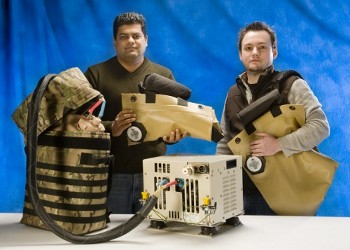 |
| March 19, 2013 | Volume 09 Issue 11 |
Designfax weekly eMagazine
Archives
Partners
Manufacturing Center
Product Spotlight
Modern Applications News
Metalworking Ideas For
Today's Job Shops
Tooling and Production
Strategies for large
metalworking plants
Military engineers teach an old water can new tricks
By Bob Reinert, USAG-Natick

Shubham Chandra (left) and Ben Williams of the Natick Soldier Research, Development and Engineering Center's Systems Equipment and Engineering Team, Department of Defense Combat Feeding Directorate, have developed a system to provide cold and hot water to Soldiers in the field and keep it that way for days.
A system developed by researchers at the Natick Soldier Research, Development, and Engineering Center, Department of Defense Combat Feeding Directorate in Natick, MA, will help bring water to Soldiers in the field, either cool or heat it, and then keep it that way for days at a time.
The system revolves around a high-stress collapsible water bag, a beverage cooling unit, and an insulated bag that holds the standard 5-gal water can or the collapsible water bag.
"Everything works together," says Ben Williams, with Combat Feeding's Systems Equipment and Engineering Team, or SEET. "You don't need to use everything together, but you can."
The system resulted from an effort to improve the standard 5-gal water can by giving it more capability.
"We didn't have a lot of money," says Shubham Chandra, who works with Williams at SEET. "We started working with what was out there."
As Williams points out, getting Soldiers to hydrate sufficiently in extreme temperatures, such as those encountered in Afghanistan, has always been a challenge.
"People aren't drinking enough, because their water is 100 degrees," Williams says. "It's not pleasurable. But if it was 40-degree water, of course you'd drink more. Your stamina also increases."
The water bag was developed after a request from the theater to replace the standard water can.
"They said, 'Hey, we want bags that can be air-dropped from at least 35 feet,'" Chandra says. "We knew the cans had a problem. The cans can't be dropped more than six feet."
The bag, made of 1050 denier nylon material and coated with silicone rubber, can be air-dropped from up to 55 ft, allowing resupply without requiring helicopters to land on remote outposts.
"It won't explode," says Williams of the bag. "If you drop a jerry can 10 feet, it will blow up. We saw an opportunity here for improvement. The standard five-gallon water can basically hasn't changed since it was created."
Storage of the collapsible water bag is also much easier.
"When it's empty, it rolls up, reducing its volume substantially," says Williams, "as opposed to the jerry can, which retains the same volume after it's been emptied. It is also substantially lighter than the water can. These features are especially important when used in a vehicle, where storage space is extremely limited."
According to Chandra, Combat Feeding has sent approximately 1,300 bags to service members in Afghanistan.
"They loved them," Williams says. "They wanted more, so we kept sending them. It's one of those little things that didn't require millions of dollars. It was developed on a minimal budget [and had] a big impact."
There was even an unforeseen use for the bags.
"They can put a cap on it and use it as a shower," Chandra says.
The bags can be connected to the beverage cooling unit, or BCU, which can cool a standard 5-gal container full of water at least 40 deg F in 25 min. The stand-alone, 40-lb unit can be plugged into any tactical vehicle or a standard wall outlet.
"It's super fast, super efficient," Williams says. "Now you have flexibility. You can cool water on demand in a standard water can or the new collapsible bags and then transfer that water to a personal hydration system via the BCU without spilling a drop. Obviously, there was a need in Iraq and Afghanistan for cold water, because they're buying ice. Instead, you could just cool the water you have back down."
Keeping water cool can be difficult in temperatures above 100 deg F as troops move around in tactical vehicles or on dismounted patrols. Heat exhaustion, heat stroke, and dehydration become formidable foes in these environments.
Williams' solution was a new insulated bag, which is 50 percent lighter than the currently fielded version and provides twice the performance. The new insulated bag can keep a can of frozen water below 70 deg F for more than four days and hot water (180 deg F) unfrozen for five days in the most extreme ambient conditions.
"It's basically a backpack that you can put the standard five-gallon water can, the water bag, or a case of bottled water into, and you can carry it on your back," Williams says. "So, once you've cooled your water with the BCU, you can take that water away and it will remain cold until you need it.
"This new design reduces the weight by over four pounds, keeps the cost the same, and increases the performance twofold."
Together, the air-droppable bag, the beverage cooling unit, and the insulated bag provide a low-cost, effective system for delivering water to the most remote areas of the field and keeping that water cold or hot.
"People don't know about this," Williams says. "If people in the field saw how it all works together, I think they would want it."
Williams and Chandra did it all with one person in mind.
"The bottom line is it really helps the war fighter," Chandra says. "That's what we're here for."
Published March 2013
Rate this article
View our terms of use and privacy policy
